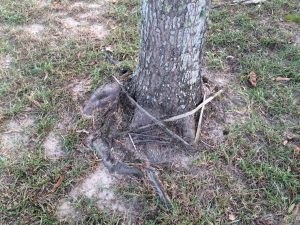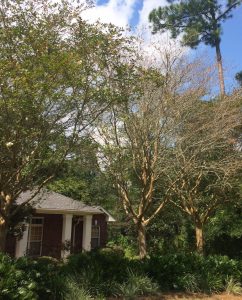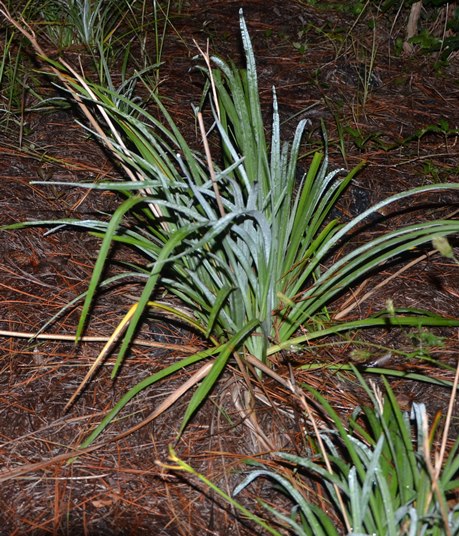

The Jackson County Master Gardeners are hosting a hosting a Mushroom Growing Workshop on Saturday, November 18 at the Jackson County Extension Office, 2741 Penn Ave., Marianna, FL.

Mysterious Growths on Bald Cypress
Bald cypress Taxodium distichum is a native tree that is commonly planted in landscapes because it is adaptable to many sites and grows quickly. It is an interesting tree because it has soft flat leaves that fall off in the winter like other deciduous shade trees; however, it belongs to the Cypress family which consists mostly of needled evergreens.
Like the other cypresses, bald cypress produces cones in the fall, which is a primary means of reproduction for the species in natural settings. During the same season that cones are maturing, you might also see what looks like cones forming at the tips of branches among the leaflets rather than along the stem. These mysterious growths are not cones but rather twig galls.
Bald cypress twig galls are abnormal growths of leaf bud tissue triggered by the attack of the cypress twig gall midge Taxodiomyia cupressiananassa. In late spring, adult midges lay eggs on new leaves of the bald cypress. As the eggs hatch and midge larvae start feeding on the bald cypress leaves the growth of a twig gall is induced. The larvae take advantage of this gall using it for food and shelter throughout the larval stage and into the pupal stage. After pupation, adults emerge from the galls, mate, and females lay an average of 120 eggs over a two-day lifespan as an adult. This first generation lays eggs on mature leaves which starts the cycle again. The galls formed by the second generation of the year fall off and overwinter on the ground.
The galls do not appear to affect the health of trees overall, although the weight of heavily infested branches may cause drooping. There are many natural enemies of the twig cypress gall midge, so applying insecticides are not recommended since they may cause harm to non-target insects. The simplest management option is to collect and destroy the galls in the spring and fall to reduce populations the following season.
To read more about bald cypress trees or the twig gall please see the following publications:
Cypress Twig Gall Midge, Taxodiomyia cupressiananassa
Taxodium distichum: Bald Cypress

An Easily Preventable Tree Planting Problem
Trees are a landscape asset for many homeowners. When a new tree is installed in our landscapes, we can’t wait for it to mature to provide shade or landscape interest. The heartbreak for many homeowners comes when this important part of their landscape, begins to decline five to ten years after establishment. We often consider a pest as the cause. The common culprit is often hidden below the mulch and soil and is easily preventable.
When larger specimen trees are installed in residential and commercial landscapes, they may be delivered with materials that help hold the rootball in place. Strapping often runs over the rootball and when trees are young is several inches away from the trunk. Installers or homeowners often do not cut the strapping during installation.

As this tree continue to grow, the rootball straps will interfere with normal trunk development. Cutting the straps takes only a few seconds at the time of planting. Photo by Beth Bolles, UF / IFAS Extension Escambia County
Over the years, tree trunks will grow in diameter and eventually reach the strapping. Because the strapping is still firmly in place, it can cut into a growing tree, resulting in girdling. Although many trees try to overcome the injured area by forming new wood over and around the girdling, this is a major stress that interferes with water and food movement in the plant. What we see is a tree that may be slower to leaf out in the spring, a thinning canopy, and twig dieback. These symptoms may be confused with another cause since the strapping is normally hidden from view.

The crape myrtle on the right has a very thin canopy. Investigation found a severe area of girdling from strapping left uncut at planting. Photo by Beth Bolles, UF / IFAS Extension Escambia County.
If you do have a tree that exhibits the above listed symptoms, it never hurts to look at the trunk and root flare just below the mulch and soil surface. If you find strapping still in place, cut it so that it is loose. Depending on the severity of the problem, this may not save the tree but it is worth a try on your important investment.

Fall is an Excellent Time to Plant Daylilies
“A penny saved is a penny earned” is the famously frugal advice from Poor Richard’s Almanac. The author Benjamin Franklin, elder statesman and founding father of the United States, offered this simple pearl of wisdom to 18th century American colonist to remind them to cautiously manage their assets.
This concept has met the test of time and had been resurrected in a variety of guises. Individuals, families, companies and governments have all applied a variation of this resource management concept, especially when their economic outlooks are challenged.
As basic as the idea is it can be applied to almost any situation, even the home landscape. Daylilies, the commonly encountered flowering ornamental in many 21st century gardens, is an excellent example of getting the most return for the least output.
The daylily is a popular flowering perennial with East Asian origins which has adapted well to Florida landscapes. Plants are available in a wide variety of growth habits, flower shapes and colors, including yellow, orange, red, pink, purple, near-white and shades and combinations of all of these.
Flowering starts in March for early-season bloomers with late-season cultivars starting in mid-May. The typical bloom period is about four to seven weeks, although some varieties bloom even longer.

Daylilies are colorful and easy to grow. Propagation is easy this time of year, just dig, separate, and replant.
As their name accurately indicates, daylilies are members of the lily family, in the genus Hemerocallis. “Hemero” is Greek for “day” and “callis” for “beauty,” so the scientific name translates to beauty for a day.
For the adventurous eater, the flower buds and petals of daylilies are edible raw, boiled, stir-fried, steamed, stuffed, or battered and fried. Dried daylily petals, called “golden needles,” are used in numerous Chinese dishes.
Many of the modern varieties of daylilies available today have been developed from native Chinese species. Early settlers from Europe and Asia brought many of the original species with them to America.
Daylilies grow best in full sun or filtered shade. The darker colored red and purple varieties flourish better in partial shade, while light colored yellows, pinks and pastels varieties need full sun to bring out their best colors.
The filtered light level under pine trees is ideal for growing daylilies. Heavy shade should be avoided because it will cause thin, spindly growth and poor flowering.
The soil pH should be between 6.2 and 6.8, with 6.5 being optimal.
The soil of daylily beds should be topped with three to four inches of organic matter, such as peat, compost, or well-rotted manure. The amended soil should be mixed or tilled, leveled and then moistened.
Daylilies survive dry conditions well because of their extensive root systems. However, the number and size of blooms, plant growth, and overall vigor can be adversely affected by prolonged drought.
Daylilies multiply fairly rapidly and plant division is an easy way to propagate them for new locations in the home landscape or to share with friends. Division is best done immediately after the flowering season.
Dig the entire clump and shake or wash off the soil without damaging the roots. It is easy to see where the divisions can be made with smaller clumps being easily pulled free to establish a new planting.
The home gardener can expand and share the beauty of these perennials and only spend a little time to accomplish this. No doubt Ben Franklin and Poor Richard would approve.
For more information, check out this excellent publication titled “Daylilies for Florida”.

Readying Your Raised Beds for Northwest Florida’s Best Gardening Season
I had to do a hard thing last week. My battle-worn okra, eggplant and pepper plants that had produced so reliably since June and endured all the summertime challenges (heat, insects, disease, and a hurricane to name a few) were finally pulled out of my raised bed garden and discarded. A combination of lowered yields, increased insect pressure, and the fact that one can only eat so much okra in a calendar year sealed their fate.
However, before planting our cool-season veggie favorites, like those tender leafy greens and wonderfully crunchy carrots, there are a few things to do to get our raised beds in shape to give maximum yield performance and make growing a little easier.
Replenish the Soil
One of the main benefits of raised beds is the ability to grow in near-perfect soil conditions. If I was relegated to gardening in my yard’s less than ideal native sandy soil, I might have given up altogether by now and I suspect many of you would be in the same boat. Raised beds totally alleviate this problem and give gardeners the opportunity to grow in rich, fertile soil composed of your favorite homemade soil mixture (mine is two parts mushroom compost to one part aged pine bark) or commercial potting mix/compost. However, at the end of each growing season, you will notice you have a bit less soil in your beds than you did at the beginning. While frustrating, this is a natural process for soils rich in organic material – they naturally break down and decompose! So to give your veggies’ roots the maximum amount of growing space for the coming season, top off your beds with a quality soil/compost mix and till it in before sowing seed or setting out transplants.
Eliminate Competing Roots
If you have a mature tree anywhere near your raised bed garden, you are going to be in for a surprise when you till that new compost in! It turns out that tree roots like that rich, fertile raised bed soil just as much as vegetables do and will seek it out. It is not uncommon for mature trees to have root systems that stretch horizontally two to three times the height of the tree, meaning a 50’ oak tree could have roots growing well over a hundred feet away from its trunk! Therefore, unless you have a totally tree-free property, battling tree roots in your beds will be an ongoing issue. For instance, each fall, when I transition from warm season to cool season crops, I find that my neighbor’s Laurel Oak has filled all three of my raised beds full of feeder roots glad to be free of the infertile sand. This is a problem because those roots suck up vital water and nutrients meant for my vegetable crops, robbing them of reaching their full potential. It is good practice to thoroughly till your beds’ soil and remove as many of the competing roots as you can. Doing so will give your new plants a head start on becoming established before the competition returns.
Depleted soil and competition from tree roots are two of the biggest threats to your raised bed’s performance. By planning ahead and accounting for both of these things prior to planting your fall garden, you will be more likely to reap a larger yields when harvest time comes! For more information on raised bed vegetable gardening and other horticultural questions, contact your local UF/IFAS Extension Office. Happy fall gardening!


